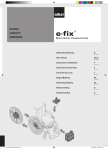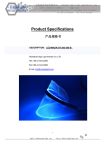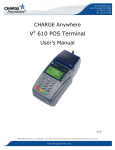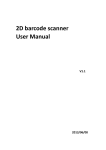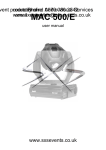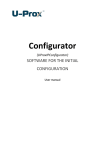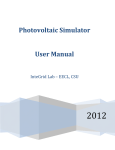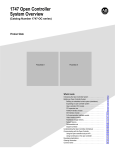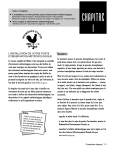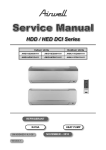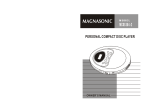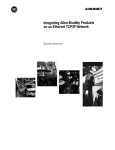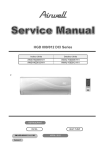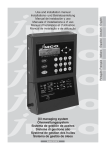Download Software Configurator User Manual - Cat. No. 931U-C9C7C-BC
Transcript
Configurator Software Catalog Number 931U-C9C7C-BC User Manual Page | 2 Foreword Foreword Revision history Version Date Change 0.0 08/25/2011 First edition Contact address Rockwell Automation 1201 South Second Street Milwaukee, Wisconsin 53204‐2496 USA Phone (1) 414‐382‐2000 Fax (1) 414‐382‐4444 Internet www.ab.com 3 Contents Contents Foreword ............................................................................................................................... 3 Revision history ........................................................................................................................................ 3 Contact address ........................................................................................................................................ 3 Contents................................................................................................................................ 4 1. Approvals ................................................................................................................. 6 1.1 CE ............................................................................................................................................... 7 1.2 UL ............................................................................................................................................... 7 1.3 ATEX ........................................................................................................................................... 7 1.4 Class 1 Division 2 ........................................................................................................................ 7 2. Notes on Safety ....................................................................................................... 8 2.1 Electrical precautions ................................................................................................................. 9 2.2 Handling ..................................................................................................................................... 9 3. Introduction ........................................................................................................... 10 3.1 Symbol identification ................................................................................................................ 11 3.2 Types / article numbers ............................................................................................................ 11 3.3 General description / applications / examples .......................................................................... 11 4. Operation ............................................................................................................... 14 4.1 Status & alarm LEDs .................................................................................................................. 15 4.2 Functional block diagram .......................................................................................................... 17 4.3 Specifications ........................................................................................................................... 18 5. Installation ............................................................................................................. 20 5.1 General (Competence Warning) ................................................................................................ 21 5.2 Mounting / Environmental / EMI protection / warm up ............................................................ 21 5.3 Electrical Connections ............................................................................................................... 22 5.4 Connection diagram ................................................................................................................. 24 6. Setup / Configuration ........................................................................................... 26 6.1 Default setting .......................................................................................................................... 27 Page | 4 Contents 6.2 931U‐CABLE USB introduction .................................................................................................. 27 6.3 Configuration / diagram wiring ................................................................................................. 28 7. 931U-C9C7C-BC Configurator Software ............................................................. 29 7.1 Description ............................................................................................................................... 30 7.2 Installation ............................................................................................................................... 30 7.3 Starting/exiting 931U‐C9C7C‐BC Configurator ........................................................................... 30 7.4 Title bar .................................................................................................................................... 31 7.5 Overview parameters ............................................................................................................... 33 7.6 Run mode ................................................................................................................................. 43 7.7 Product identification ............................................................................................................... 44 8. Troubleshooting .................................................................................................... 46 8.1 Troubleshooting ....................................................................................................................... 47 Appendix ............................................................................................................................. 49 Index .................................................................................................................................................50 Page | 5 Contents 1. Approvals 1.1 CE ............................................................................................................................................... 7 1.2 UL ............................................................................................................................................... 7 1.3 ATEX ........................................................................................................................................... 7 1.4 Class 1 Division 2 ........................................................................................................................ 7 Page | 6 1.1 CE CE Declaration is available from Rockwell Automation. 1.2 UL Listing approval cULus 1.3 ATEX Approval according ATEX directive EN 60079‐0 and EN 60079‐15 for NON Sparking 1.4 Class 1 Division 2 Approval according C1D2 Zone 2: ISA121201 Page | 7 2. Notes on Safety 2.1 Electrical precautions ................................................................................................................. 9 2.2 Handling ..................................................................................................................................... 9 Page | 8 2.1 Electrical precautions There are no procedures which involve the user re‐ moving the product electronics from its housing. Set‐up or Re‐configuration (see chapter 6) is via a connector located behind the front cover, which is opened with the use of a small screwdriver (see Figure 1). 140H DANGER! This product may be connected to po‐ tentially lethal voltages! 14H DANGER! The configuration plug jack must only be used for configuration in non‐ hazardous areas! WARNING! • Before you remove or mount the unit, turn‐off the power supplies – i.e. to the instrument and to the re‐ lays, if used. • Product electronics must not be re‐ moved from its enclosure without disconnecting power sources. • Follow ESD installation regulations, including the EMI precautions given in chapter 5. 139H Figure 1 2.2 Handling Check on receipt that the product received corre‐ sponds to the one ordered. Handling Unpack the 931U‐C9C7C‐BC carefully, and ensure the Installation instruction sheet is kept with the product until it is permanently mounted. Page | 9 3. Introduction 3.1 Symbol identification ................................................................................................................ 11 3.2 Types / article numbers ............................................................................................................ 11 3.3 General description / applications / examples .......................................................................... 11 Page | 10 3.1 Symbol identification 3.3 DANGER! Potentially lethal voltages. The CE mark proves the compliance of the product with the requirements of the directives. 3.2 Types / article numbers This User Manual covers the following products: 931U‐C9C7C‐BC Signal Conditioner 931U‐CABLE Programming Cable General description / applications / examples The 931U‐C9C7C‐BC is an accurate and stable signal converter / isolator / alarm generator for use in measurement and control systems. A wide variety of input / output range and type settings can be configured, using the 931U‐CABLE Programming Cable and the 931U‐C9C7C‐BC Configurator soft‐ ware. The 931U‐C9C7C‐BC can be powered from DC or AC sources between 18 and 264 volts. The primary characteristic of the 931U‐C9C7C‐BC is its versatility of input / output configurability. Hence many of the standard functions performed by DIN rail mounted signal conditioners can be done by the 931U‐C9C7C‐BC, such as • Conversion (current to voltage, and vice versa) • Isolation of temperature sensor and DC inputs • Linearization of temperature sensor inputs • Transmission of sensor signals over long distance • Characterizing signals from DC transmitters • Process alarm generation • Relay control between high and low values can be done by the 931U‐C9C7C‐BC Page | 11 Typical Applications Typical of applications for the 931U‐C9C7C‐BC is the conversion of thermocouple temperature input (low range of millivolts) into a high level (e.g. 4‐20 mA) value for transmission to a control system. In this type of installation the 931U‐C9C7C‐BC pro‐ vides: • Linearization of the standard thermocouple temperature/millivolts characteristic. • Isolation of the input signal to the control sys‐ tem. This allows the user to use a thermocouple with a grounded hot junction for a quick re‐ sponse at the measurement point. This would otherwise convey electromagnetic influences (high frequency noise) into the control system. • Selectable output value for a thermocouple‐ break event. • Flashing LED status indicator on the unit front on thermocouple‐break. • Relay alarm output if required on thermocouple‐ break. • Relay alarm output on high or low process tem‐ perature. Page | 12 ϑ V, I V, I V PS Figure 2 Installation n overview Page | 13 3 4. Operation 4.1 Status & alarm LEDs .................................................................................................................. 15 4.2 Functional block diagram .......................................................................................................... 17 4.3 Specifications ........................................................................................................................... 18 Page | 14 4.1 S Status & alarm a LE EDs Inp put short circcuit fllashes at 5 H Hz Status LED Cold Junction e error s, 2 pulses 2 2 pulses, rest Under norm mal condition ns this (green n) LED is on ccon‐ tinuously. Flash memory e error 3 pulses, rests, 3 pulses Tablle 1 Stattus Indicatorrs A B C Figure 3 LEDs A Status LE ED B ALARM 2 2 C ALARM 1 1 The followin ng table show ws how alarm m conditionss are displayed. Status in ndicator Alarm conditions c Normal staatus continuo ously on Input open n circuit flashes at 0.5 Hz Page | 15 5 Analog Output status with alarm • User may select output value under fault condi‐ tions • Output compliant with NAMUR recommenda‐ tions (NE43) can be set (< 3.6 mA or > 21 mA) Input fault detection Input faults such as short circuit or open circuit can be detected for most input types. These are shown in the table below. Input type Detection Open circuit Short circuit Thermocouple Yes Yes RTD Yes Yes Millivolts Yes No Volts (Positive) Yes No Milliamps (Passive) Yes* No Milliamps (Ac‐ tive) Yes Yes Resistance Yes Yes Potentiometer Yes Yes** Table 2 Input fault detection * Open circuit not detected for live zero ranges ** Short circuit for end‐to‐end Page | 16 4.2 Functiona al block diagram d Figure 4 Functional block diagraam Page | 17 7 4.3 Specifications Input types Thermocouple Range ‐200...+1820 °C Types B, E, J, K , L, N, R, S, T to IEC 60584 plus custom specific RTD 2, 3, 4 wire, within the range ‐200...+850 °C, for Pt100, Pt1000 to IEC 60571 and for Ni100 / Ni1000 to DIN 43760, for Cu10 and,100 plus custom specific Potentiometer 10 Ω...100 kΩ Resistance 10 Ω...5 kΩ Frequency 2 Hz...100 kHz Voltage within the range ‐200...600 mV (min span 4 mV), within the range ‐20...50 V DC (min span 0.5 V) Current within the range ‐20...50 mA (min span 1 mA) Current Loop supply +24 V DC Sensor break output Selectable between ‐2% and 102% output Analog Output DC voltage 0...5, 1...5, 0...10, 2...10 V or span‐settable between ‐10...10 V (min span 2.5 V) DC current 0...20, 4...20, 0...10 mA, or span‐settable between 0...20 mA (min span 5 mA) Max load (current / voltage) 700 Ω / >10 kΩ (>20 kΩ for ‐10 V…+10 V) Action Direct or Inverted Operation Digital Output Relay Relays 2 x SPCO Max voltage and current AC 250 V AC / 2 A Max voltage and current DC 30 V DC / 2 A General Data Rated voltage 24...240 V AC/DC 24…36 V AC / 24…50 V AC (ATEX Zone 2) Page | 18 Min. / max. power supply (according VDE) 18…264 V AC/DC 18…40 V AC / 18…56 V DC (ATEX Zone 2) Rated power < 3,5 W Ambient operating range ‐40...+70 °C Isolation test 1,5 kVrms / 1 min. between PE and power supply, as well as between PE and input or output 2,5 kVrms / 1 min between input and output Rated insulation voltage 300 V protective separation between power supply and input or output, as well as between Relay output and all other circuits 100 V protective separation between input and output 300 V basic insulation between input and output Performance Accuracy DC, RTD inputs <0.1% span. Thermocouple inputs: 0.2% span (or 1 °C) + CJ error Ambient temp effects DC & RTD inputs < 0.01%/K Thermocouple inputs < 0.01% of full scale/K + CJ error 0.07 °C/K Step Response/ Cut‐off Frequency Settable within 60 ms ‐1880 ms / 1 Hz (3 dB) Physical Dimensions 92.4 x 112.5 x 45 mm No. of connections 12 Connection types screw Housing material UL 94 V0 Housing color Gray Ingress protection IP20 Approvals CE, cULus, GL Approvals CE, cULus, Class 1 Division 2 / Zone 2, ATEX Zone 2 Table 3 Specifications Page | 19 5. Installation 5.1 General (Competence Warning) ................................................................................................ 21 5.2 Mounting / Environmental / EMI protection / warm up ............................................................ 21 5.3 Electrical Connections ............................................................................................................... 22 5.4 Connection diagram ................................................................................................................. 24 Page | 20 5.1 General (Competence Warning) The 931U‐C9C7C‐BC should only be installed by technically qualified personnel with sufficient quali‐ fication or knowledge in the subject of instrumenta‐ tion and control engineering. 5.2 Mounting / Environmental / EMI protection / warm up Mounting 931U‐C9C7C‐BC is designed to be mounted onto a TS35 DIN rail. Environment The 931U‐C9C7C‐BC is designed for use either in‐ doors (IP20) in a control panel, or in a weather‐ proof field enclosure. Its atmosphere should be dry, well ventilated and dust‐free. Avoid mounting in locations subject to vibration or physical impact. The 931U‐C9C7C‐BC is suitable for EX applications and approved for installation in Zone 2. They shall be installed in an enclosure providing a degree of protection of at least IP54. It clips onto the rail via a spring‐loaded mounting foot, and can be removed via a spring release on the edge of the product near the mounting rail. EMI protection Do not install input, output and power supply ca‐ bles close to sources of electrical interference. For example, such sources could include relays, contac‐ tors, motors and their controls, including thyristor drives, and the cables which connect these devices. Avoid installing 931U‐C9C7C‐BC cables in the same ducting as such cables. Local electrical installation practices should be fol‐ lowed. Figure 5 Mounting on DIN rail Warm-up The product is designed to function as soon as power is supplied. However a warm‐up period of 15 minutes is required before it performs to the speci‐ fications above. NOTICE Page | 21 When auxiliary power is switched on, for the first 200 ms the 931U‐C9C7C‐BC will consume up to 200 mA. 5.3 Electrical Connections Input, output and power supply wiring is made via numbered, pluggable connectors, which may be screw clamp or tension clamp type, depending on the item article number. The connectors are coded to prevent the power supply connector being fitted in the wrong position. Test terminals are included to permit input and output currents to be monitored without discon‐ nection of cables (see connection diagram below). WARNING! 931U‐C9C7C‐BC and PC have to be fully de‐energized, before the programming interfaces 931U‐CABLE will be connect‐ ed. NOTICE Ensure that the connectors are inserted into the correct position (see connection diagram). Page | 22 Page | 23 5.4 Connection diagram The connection diagram below is printed on the side of the 931U‐C9C7C‐BC housing. Connection diagram – Power supply Term. No. 24 0 V 25 PE 26 24 ‐ 240 V DC / AC Table 4 Power supply Connection diagram – Input IPassive <50 mA IActive <20 mA V <50 V TC / V <600 mV 11 In‐ In‐ 12 13 14 Term. No. Resistor / RTD 2Wire 3-Wire 4-Wire Poti Freq In‐ R‐ R‐ R‐ Start In‐ In+ Sense‐ Sense‐ End R+ R+ R+ Wiper +24 V 15 In+ / TP+ IReturn / TP+ 16 TP‐ TP‐ 21 In+ In+ (<50 V) 22 In+ (<30 V) 23 Sense+ Table 5 Input Page | 24 Connection diagram – Analog output Term. No. 0…20 mA 0…10 V -10 V…+10 V 31 TP+ 32 Out+ / TP‐ 33 Out‐ 41 Out‐ 42 Out+ Out+ 43 Out‐ Table 6 Analog output Connection diagram – Digital output relay Term. No. Alarm 1 Alarm 2 34 N/C 35 N/O 36 COM 44 N/C 45 N/O 46 COM Table 7 Digital output Page | 25 6. Setup / Configuration 6.1 Default setting .......................................................................................................................... 27 6.2 931U‐CABLE USB introduction .................................................................................................. 27 6.3 Configuration / diagram wiring ................................................................................................. 28 Page | 26 6.1 Default setting 6.2 931U-CABLE USB introduction The 931U‐CABLE is the configuration interface for the 931U‐C9C7C‐BC. This is the same interface as can be used for configuring the 931U‐C9A2C‐OP Signal conditioner. Input range 4‐20 mA ADS Speed medium Transfer function Linear Response time 0.25 s Output range 4‐20 mA Connection to the computer is via USB port, and to the 931U‐C9C7C‐BC via a jack connector. Tx and Rx status are indicated by LEDs on the 931U‐CABLE. Action direct Low limit 0 mA High Limit 20 mA Output @ error 21.5 mA Digital outputs 1 and 2 Disabled Table 8 Default settings Page | 27 6.3 C Configura ation / diagram wiring w Con nnection to 9 931U‐ C9C C7C‐BC is under the fron nt cover 931U‐CAB BLE with conn nection to the USB B port on com mputer 1606 6 Power Supp ply AC Poweer Figure 6 Configuratiion / diagram m wiring Page | 28 8 7. 931U-C9C7C-BC Configurator Software 7.1 Description ............................................................................................................................... 30 7.2 Installation ............................................................................................................................... 30 7.3 Starting/exiting 931U‐C9C7C‐BC Configurator ........................................................................... 30 7.4 Title bar .................................................................................................................................... 31 7.5 Overview parameters ............................................................................................................... 33 7.6 Run mode ................................................................................................................................. 43 7.7 Product identification ............................................................................................................... 44 Page | 29 7.1 D Descriptio on The Window ws based 931U‐C9C7C‐BC C Configurattor software is used to set u up the 931U‐C9C7C‐BC vvia the interfacce 931U‐CAB BLE. 1 on your ccomputer desktop. 2 7.2 In nstallatio on D Double‐click on the icon C Click on the W Windows Staart button, th hen select: P Programs > A Allen‐Bradleyy > 931U‐C9C C7C‐BC Con‐ figurator > 93 31U‐C9C7C‐B BC Configuraator System Re equiremen nts Exitting 931U-C C9C7C-BC Configura ator • Operatio on system W Windows 2000 0 (SP4+), Win n‐ dows XP P, Windows V Vista You can exit 931 1U‐C9C7C‐BC C Configurato or in the fol‐ lowiing ways. • IBM PC w with a spare USB port 1 C Click the Exit button. 2 C Click the X on n the window w frame. • 931U‐CA ABLE Installatio on note N NOTICE In order to in nstall the pro ogram you ne eed aadministrato or rights on th he computerr involved. 31U‐C9C7C‐B BC Configuraator: Installing 93 The 931U‐C C9C7C‐BC Configurator so oftware can be installed witth the file "ssetup.exe". 7.3 S Starting/e exiting 93 31UC C9C7C-BC C Config gurator Starting 931U-C9C7C C-BC Conffigurator You can start 931U‐C9C C7C‐BC Configgurator in tw wo different waays: Page | 30 0 7.4 T Title bar Setttings File Tem mperature un nit Set the unit of the tem mperature for the co onfiguration.. Celsius or Fahrenhe eit New Chan nge the setting to defaultt settings. Open n a configuraation file *.ttta Open from m the hard disk. Save Savee the actuallyy configuratio on to a file *.tta. Figure 9 Print Printt the actuallyy configuration. Exit Exit tthe softwaree 931U‐C9C7 7C‐ BC C Configurator. Titlee bar ‐ Settin ngs ‐ Temperrature unit point / Setp Running Values Settings ffrom the unitt (percent or input u units) of the trigger level of the diggital outputs and the in‐ put unit o of the runnin ng value in‐ dication. Figure 7 Title bar ‐ FFile Figure 10 Titlee bar ‐ Settin ngs ‐ Set poin nt unit Language e The menu text will be displayed dep pending on the selection in English or G German langu uage. Figure 8 Title bar ‐ LLanguage Page | 31 Info About Open n an informaation window w abou ut the softwaare version aand the ccontact addrress of Allen‐‐ Brad dley Figure 11 Title bar ‐ Info Page | 32 2 7.5 Overview parameters Input parameters Type of input Voltage ‐ Range V: ‐20 … +50 V DC Min. Span 0.5 V mV: ‐200 … +500 mV DC Min. Span: 4 mV Current ‐ Range Passive Range mA: ‐20 … +50 mA Min. Span: 1 mA Active Range mA: 0 … +20 mA Min. Span: 1 mA Type of Thermocouple K: ‐200 … +1372 °C J: ‐210 … +1200 °C T: ‐200 … +400 °C E: ‐200 … +1000 °C N: ‐200 … +1300 °C R: ‐50 … +1767 °C S: ‐50 … +1767 °C B: +50 … +1820 °C L: ‐200 … +900 °C U: ‐200 … +600 °C User defined RTD RTD type: Connection type: PT100 PT1000 NI100 NI1000 NI120 Cu10 Ω at 25 °C Cu100 Ω at 0 °C User defined 2‐wire 3‐wire 4‐wire Resistor ‐ Range 10 Ω… 5 kΩ Potentiometer ‐ Range 10‐50 Ω 50‐100 Ω 100‐200 Ω 200‐400 Ω 400‐800 Ω 800‐2 kΩ 2 k‐6.5 kΩ 6.5 k‐100 kΩ Frequency ‐ Sensitivity Frequency range: Min. Span: 2 Hz … 100 kHz 10 Hz Page | 33 Voltage range Pin21: Voltage range Pin22: ‐50 V … +50 V DC ‐30 V … +30 V DC Pin High noise reduction High Level Low noise reduction Low Level Max. voltage range 22 550 mV 140 mV ±30 V 21 7.8 V 1.9 V ±50 V Page | 34 Transfer parameters Transfer function Transfer function for the output signal: Function formula linear SQRT X^1.5 0,5 Out = In Out = In Out = In x 0.1 x 10 1,5 X^2 X^2.5 2 Out = In x 0.01 Out = In2,5 x 0.001 Input in % Output in % Output in % Output in % Output in % Output in % 0 0 0 0 0 0 10 10 32 3 1 0.3 20 20 45 9 4 2 30 30 55 16 9 5 40 40 63 25 16 10 50 50 71 35 25 18 60 60 77 46 36 28 70 70 84 59 49 41 80 80 89 72 64 57 90 90 95 85 81 77 100 100 100 100 100 100 In the SQRT function has low flow cut off. If the input Is smaller than 1% the out is zero. Page | 35 Figure 1 12 Transffer functionss Figure 1 13 ADC Speed d User‐d defined transsfer function n Fastt Hig ghest sampling ratte 9.5 ms Page | 36 6 Medium 50 ‐ 60 Hz 60 ms Slow 50 ‐ 60 Hz 180 ms Response Time Response time is the time between an input step and the output step. ADC speed Respons e time in ms Voltage / Current mV / Therm o Potentiometer / RTD 3-Wire RTD 2-Wire 4-Wire min. 140 60 90 60 max. 1000 1000 1000 1000 min. 250 170 350 180 max. 1070 1000 950 1050 min. 525 460 1020 470 max. 1350 1280 1880 900 Fast Medi‐ um Slow Range response time Page | 37 Analog output parameters Type of output Voltage Current Voltage Max. Range: ‐10.1 … +11 V DC Max. Range: 0 mA to 20 mA DC Min. Span: 2.5 V DC Min. Span: 5 mA DC Lowest Value Lowest Value Output – range low Output – range high This is the minimum voltage value This is the minimum current value at the output (related to 0% input). at the output (related to 0% in‐ put). Highest Value Highest Value This is the value at the output (re‐ lated to 100% input). This is the maximum current value at the output (related to 100% in‐ put). Direct action is output increasing as input increases. Reverse action is output decreas‐ ing as input increases. Direct action is output increasing as input increases. Reverse action is output decreas‐ ing as input increases. Direct or reverse function Output – low limit Low Limit Output – high lim‐ it Low Limit This is the lowest possible value at the output. This is the lowest possible value at the output. High Limit High Limit This is the highest possible value at the output. This is the highest possible value at the output. Output – for error Output @ Error condition If an input or 931U‐C9C7C‐BC er‐ ror occurs the output is set to this value. Output @ Error If an input or 931U‐C9C7C‐BC error occurs the output is set to this val‐ ue. Page | 38 Digital ou utput param meters Alarm outp put Operating modes Function Dissabled The alarm is disabled. Low w Type The alarm is sw witched on, iff the input value is lowerr than the seetpoint. Higgh Type The alarm is sw witched on, iff the input value is highe er than the seetpoint. Wiindow The alarm is sw witched on, iff the input value is outsid de the windo ow value: win ndow range = setpoint ± window value e.gg.: setpoint 4 40%, window w 10% = wind dow value is from 30‐50% %. Inp put Error If aan input or 9 931U‐C9C7C‐‐BC error occcurs the outp put is set to tthis value. ON N The alarm relayy is activated d after poweer on. Function ccir‐ cuit Alarm Relay No ormally energgised No alarm Alarm Coil on Coil off No alarm Alarm Coil off Coil on No ormally de‐en nergised Settings Setpoint This is the relayy switch on vvalue 0…100 0% Deadb band Sw witch off hystteresis in perrcent e.gg. high type, setpoint 50% % and deadb band 2%: thee alarm switcches on if thee value reach hes 50% and switches offf if the valuee decreases tto 48%. Page | 39 9 ON Deelay Sw witch on delay in secondss In 0.1 second ssteps OFF Deelay Sw witch off delaay in secondss In 0.1 second ssteps Windo ow Sett a range aro ound the Setpoint in perccent Error A Action Alaarm ON The alarm relayy is activated d when an errror is detectted. Alaarm OFF The alarm relayy is deactivated when an n error is detected. Ho old The alarm relayy hold the acctually statuss. No one No o reaction on n an error. Table 9 Parameter m High Alarm Low w Alarm Figure 14 Figure 15 High Alarm m Low w Alarm Page | 40 0 Window A Alarm Figure 16 Window Allarm Page | 41 Alarm Tim me Delay Figure 17 Alarm Timee Delay mple the timee delay is sett for 20 seconds. At t1 thee measurement exceeds the alarm value, but In this exam this only lassts for 10 secconds so there is no trip. At t2 the meeasurement again exceed ds the alarm trip value and this lastts for longer than 20 seconds so the alarm trip occcurs after 20 seconds. Page | 42 2 7.6 Run mode Start communication with the 931U‐C9C7C‐BC 1 Connect the 931U‐C9C7C‐BC to a Power supply. 2 Connect the 931U‐C9C7C‐BC with the 931U‐ CABLE to an available USB port on the PC. 3 Start the 931U‐C9C7C‐BC Configurator Software. 4 Input configuration Select the input value. 5 Output configuration Select the output value. 6 Alarm configuration Set the alarm relay behaviour. 7 Send configuration to 931U‐C9C7C‐BC. The button "Save to Instrument” transmits the new configuration to the 931U‐C9C7C‐BC. 8 Enter Password Enter your password (the default password is 0000). 9 Read Values With the button "Read Values” the actual values of the 931U‐C9C7C‐BC are displayed in the win‐ dow "Running values”. If the button "Read Continuous” is activated the values are updated every second (monitoring). 10 Read from Instrument To check the current configuration in the con‐ nected 931U‐C9C7C‐BC click on the "Read from instrument” button. • Output: 931U‐C9C7C‐BC output value in percent. • CJC Temperature: This the temperature in Centi‐ grade or Fahrenheit at the cold junction point in the 931U‐C9C7C‐BC. • Alarm1: Shows the status of the first alarm relay - LED = red = relay switched on (alarm) - LED = off = relay switched off (no alarm) Running values • Input: 931U‐C9C7C‐BC input value in percent. Page | 43 • Alarm2: Shows the status of the second alarm relay Table 10 Product identification - LED = red = relay switched on (alarm) - LED = off = relay switched off (no alarm) 7.7 Product identification Unit Type: Description of the module Serial No.: The serial number is printed on the side of the module. Firmware No.: The firmware number of the 931U‐C9C7C‐BC which is connected. Configured by: The company name of the person who last config‐ ured the module. Initials: Initials or the name of the person who last config‐ ured the module. Date: The date when the mod‐ ule was last configured the module. ID Tag: Typically, the user’s plant reference User Reference: User descriptor Version: The Version of the soft‐ ware Terminals: Shows the terminal num‐ ber where the sensor and output signals are con‐ nected. Page | 44 A Figure 18 Unit‐ID A Terminals Page | 45 5 8. Troubleshooting 8.1 Troubleshooting ....................................................................................................................... 47 Page | 46 8.1 T Troublesh hooting If a 931U‐C9 9C7C‐BC is not working aas expected, the best view of its complette set‐up is vvia the 931U‐‐ C9C7C‐BC C Configurator Software. Below are ssome examples of checkss which can h help the user oveercome conn nection or co onfiguration er‐ rors. D indication No Status LED C‐BC is installed, the wiring is done, The 931U‐C9C7C on. but it shows no LED indicatio 1 C Check the po ower supply aand considerr the wiring d diagrams and d description ns in chapter 4 and 5. 169H 2 170H EEnsure that the input / ou utput connections are ccorrect. No communications ation is bein ng checked d, 931U‐C9C C7C‐ Configura BC Configurrator soft‐waare is installeed, the 931U‐ C9C7C‐BC iss connected via the 931U U‐CABLE, butt there is no ccommunicattion. Figure 19 Com Port cconfiguration n and settinggs or hardware p problem. It could be aa software o 1 Check yo our comport settings. The 931U‐C9C7 7C‐ BC Confiigurator will show (on the top left) th he current U USB comporrt. 2 Check th hat the 931U U‐CABLE is co onnected be‐‐ tween th he 931U‐C9C C7C‐BC and yyour computter. 3 Check th hat the 931U U‐C9C7C‐BC iss powered w with‐ in the range given in the specifications. Page | 47 7 The green Status LED is flashing It indicates sensor wiring (short circuit or open cir‐ cuit) or internal fault. See description in chapter 3 to identify fault source. 17H The DC output is incorrect 1 Ensure the input type and range are configured as required and wiring connections are correct. 2 Check the output configuration settings for cor‐ rect range and transfer functions including direct or re‐verse action. The alarm relays have no function 1 Check the relay configuration settings including set‐point, alarm type are as required and as de‐ scribed in chapter Error! Reference source not found.. 172H 2 Check the input type and range is as required. 3 Check the input connections are made correctly. The alarm relays are on / off with the wrong values of input 1 Check the relay configuration settings including set‐point, alarm type are as required and as de‐ scribed in chapter Error! Reference source not found.. 173H 2 Check the input type and range is as required. 3 Check the input connections are made correctly. Page | 48 Appendix Index ……………………………………………………………………………………………………………….50 Page | 49 Index Figure Page Figure 1 Handling 9 Figure 2 Installation overview 13 Figure 3 LEDs 15 Figure 4 Functional block diagram 17 Figure 5 Mounting on DIN rail 21 Figure 7 Configuration / diagram wiring 28 Figure 8 Title bar ‐ File 31 Figure 9 Title bar ‐ Language 31 Figure 10 Title bar ‐ Settings ‐ Temperature unit 31 Figure 11 Title bar ‐ Settings ‐ Set point unit 31 Figure 12 Title bar ‐ Info 32 Figure 13 Transfer functions 36 Figure 14 User‐defined transfer function 36 Figure 15 High Alarm 40 Figure 16 Low Alarm 40 Figure 17 Window Alarm 41 Figure 18 Alarm Time Delay 42 Figure 19 Unit‐ID 45 Figure 21 Com Port configuration and settings 47 Page | 50 Table Page Table 1 Status Indicators 15 Table 2 Input fault detection 16 Table 3 Specifications 19 Table 4 Power supply 24 Table 5 Input 24 Table 6 Analog output 25 Table 7 Digital output 25 Table 8 Default settings 27 Table 9 Parameter 40 Table 10 Product identification 44 Table 11 Article overview Error! Bookmark not defined. Page | 51 Rockwell Automation 1201 South Second Street Milwaukee, Wisconsin 53204‐2496 USA Phone Fax Internet (1) 414‐382‐2000 (1) 414‐382‐4444 www.ab.com DIR 10000203490 (Version 00) Allen-Bradley and Rockwell Software are trademarks of Rockwell Automation, Inc. Publication 931-UM001A-EN-P -August 2011 - DIR 10000203490 (Version 00) Copyright ©2011 Rockwell Automation, Inc. All Rights Reserved. Printed in USA.






















































